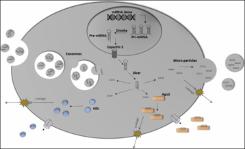Mostrar el registro sencillo del ítem
A multi-faceted genotoxic network of alpha-synuclein in the nucleus and mitochondria of dopaminergic neurons in Parkinson’s disease: Emerging concepts and challenges
| dc.contributor.author | Vasquez, Velmarini | |
| dc.contributor.author | Mitra, Joy | |
| dc.contributor.author | Wang, Haibo | |
| dc.contributor.author | Hegde, Pavana M | |
| dc.contributor.author | Rao, KS Jagannatha | |
| dc.contributor.author | Hegde, Muralidhar L | |
| dc.date.accessioned | 2020-06-16T00:02:03Z | |
| dc.date.available | 2020-06-16T00:02:03Z | |
| dc.date.issued | 2020-02-01 | |
| dc.identifier.other | https://doi.org/10.1016/j.pneurobio.2019.101729 | |
| dc.identifier.uri | http://repositorio-indicasat.org.pa/handle/123456789/67 | |
| dc.description | α-Synuclein is a hallmark amyloidogenic protein component of the Lewy bodies (LBs) present in dopaminergic neurons affected by Parkinson’s disease (PD). Despite an enormous increase in emerging knowledge, the mechanism(s) of α-synuclein neurobiology and crosstalk among pathological events that are critical for PD progression remains enigmatic, creating a roadblock for effective intervention strategies. One confounding question is about the potential link between α-synuclein toxicity and genome instability in PD. We previously reported that pro-oxidant metal ions, together with reactive oxygen species (ROS), act as a “double whammy” in dopaminergic neurons by not only inducing genome damage but also inhibiting their repair. Our recent studies identified a direct role for chromatin-bound, oxidized α-synuclein in the induction of DNA strand breaks, which raised the question of a paradoxical role for α-synuclein’s DNA binding in neuroprotection versus neurotoxicity. Furthermore, recent advances in our understanding of α-synuclein mediated mitochondrial dysfunction warrants revisiting the topics of α-synuclein pathophysiology in order to devise and assess the efficacy of α-synuclein-targeted interventions. In this review article, we discuss the multi-faceted neurotoxic role of α-synuclein in the nucleus and mitochondria with a particular emphasis on the role of α-synuclein in DNA damage/repair defects. We utilized a protein-DNA binding simulation to identify potential residues in α-synuclein that could mediate its binding to DNA and may be critical for its genotoxic functions. These emerging insights and paradigms may guide new drug targets and therapeutic modalities. | en_US |
| dc.description.abstract | α-Synuclein is a hallmark amyloidogenic protein component of the Lewy bodies (LBs) present in dopaminergic neurons affected by Parkinson’s disease (PD). Despite an enormous increase in emerging knowledge, the mechanism(s) of α-synuclein neurobiology and crosstalk among pathological events that are critical for PD progression remains enigmatic, creating a roadblock for effective intervention strategies. One confounding question is about the potential link between α-synuclein toxicity and genome instability in PD. We previously reported that pro-oxidant metal ions, together with reactive oxygen species (ROS), act as a “double whammy” in dopaminergic neurons by not only inducing genome damage but also inhibiting their repair. Our recent studies identified a direct role for chromatin-bound, oxidized α-synuclein in the induction of DNA strand breaks, which raised the question of a paradoxical role for α-synuclein’s DNA binding in neuroprotection versus neurotoxicity. Furthermore, recent advances in our understanding of α-synuclein mediated mitochondrial dysfunction warrants revisiting the topics of α-synuclein pathophysiology in order to devise and assess the efficacy of α-synuclein-targeted interventions. In this review article, we discuss the multi-faceted neurotoxic role of α-synuclein in the nucleus and mitochondria with a particular emphasis on the role of α-synuclein in DNA damage/repair defects. We utilized a protein-DNA binding simulation to identify potential residues in α-synuclein that could mediate its binding to DNA and may be critical for its genotoxic functions. These emerging insights and paradigms may guide new drug targets and therapeutic modalities. | en_US |
| dc.language.iso | en | en_US |
| dc.subject | α-synuclein | en_US |
| dc.subject | Parkinson’s disease | en_US |
| dc.subject | Lewy bodies | en_US |
| dc.subject | DNA damage | en_US |
| dc.subject | Mitochondrial dysfunction | en_US |
| dc.subject | Protein misfolding/aggregation | en_US |
| dc.title | A multi-faceted genotoxic network of alpha-synuclein in the nucleus and mitochondria of dopaminergic neurons in Parkinson’s disease: Emerging concepts and challenges | en_US |
| dc.type | Article | en_US |

